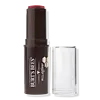What's inside
What's inside
 Key Ingredients
Key Ingredients

No key ingredients
 Benefits
Benefits

 Concerns
Concerns

 Ingredients Side-by-side
Ingredients Side-by-side

Simmondsia Chinensis Seed Oil
EmollientHelianthus Annuus Seed Oil
EmollientCera Alba
EmollientBeeswax
Emulsion StabilisingCocos Nucifera Oil
MaskingRaphanus Sativus Seed Extract
Skin ConditioningRicinus Communis Seed Oil
MaskingLauryl Laurate
Skin ConditioningMica
Cosmetic ColorantTheobroma Grandiflorum Seed Butter
Skin ConditioningSilica
AbrasiveRosmarinus Officinalis Leaf Extract
AntimicrobialTocopherol
AntioxidantGlycine Soja Oil
EmollientLinoleic Acid
CleansingLinolenic Acid
CleansingWater
Skin ConditioningAlumina
AbrasiveAroma
Linalool
PerfumingCI 75470
Cosmetic ColorantIron Oxides
CI 77891
Cosmetic ColorantTitanium Dioxide
Cosmetic ColorantSimmondsia Chinensis Seed Oil, Helianthus Annuus Seed Oil, Cera Alba, Beeswax, Cocos Nucifera Oil, Raphanus Sativus Seed Extract, Ricinus Communis Seed Oil, Lauryl Laurate, Mica, Theobroma Grandiflorum Seed Butter, Silica, Rosmarinus Officinalis Leaf Extract, Tocopherol, Glycine Soja Oil, Linoleic Acid, Linolenic Acid, Water, Alumina, Aroma, Linalool, CI 75470, Iron Oxides, CI 77891, Titanium Dioxide
Water
Skin ConditioningDiisostearyl Malate
EmollientBis-Diglyceryl Polyacyladipate-2
EmollientDiphenylsiloxy Phenyl Trimethicone
Skin ConditioningDimethicone
EmollientHydrogenated Polyisobutene
EmollientButylene Glycol
HumectantGlycerin
Humectant1,2-Hexanediol
Skin ConditioningSteareth-20
CleansingCetearyl Alcohol
EmollientCetyl PEG/PPG-10/1 Dimethicone
EmulsifyingHydroxyethyl Acrylate/Sodium Acryloyldimethyl Taurate Copolymer
Emulsion StabilisingPolysorbate 60
EmulsifyingPhenoxyethanol
PreservativeSqualane
EmollientEthylhexylglycerin
Skin ConditioningParfum
MaskingDisodium EDTA
Sorbitan Isostearate
EmulsifyingAluminum Hydroxide
EmollientAmmonium Polyacrylate
StabilisingArgania Spinosa Kernel Oil
EmollientButyrospermum Parkii Butter
Skin ConditioningCamellia Japonica Seed Oil
EmollientGlyceryl Caprylate/Caprate
EmollientSimmondsia Chinensis Seed Oil
EmollientPrunus Amygdalus Dulcis Oil
Skin ConditioningPrunus Armeniaca Kernel Oil
MaskingOenothera Biennis Oil
EmollientOlea Europaea Fruit Oil
MaskingMangifera Indica Fruit Extract
Skin ConditioningElaeagnus Glabra Fruit Extract
Skin ConditioningTitanium Dioxide
Cosmetic ColorantCI 19140
Cosmetic ColorantCI 17200
Cosmetic ColorantBasic Red 1:1
Blue 1 Lake
Cosmetic ColorantWater, Diisostearyl Malate, Bis-Diglyceryl Polyacyladipate-2, Diphenylsiloxy Phenyl Trimethicone, Dimethicone, Hydrogenated Polyisobutene, Butylene Glycol, Glycerin, 1,2-Hexanediol, Steareth-20, Cetearyl Alcohol, Cetyl PEG/PPG-10/1 Dimethicone, Hydroxyethyl Acrylate/Sodium Acryloyldimethyl Taurate Copolymer, Polysorbate 60, Phenoxyethanol, Squalane, Ethylhexylglycerin, Parfum, Disodium EDTA, Sorbitan Isostearate, Aluminum Hydroxide, Ammonium Polyacrylate, Argania Spinosa Kernel Oil, Butyrospermum Parkii Butter, Camellia Japonica Seed Oil, Glyceryl Caprylate/Caprate, Simmondsia Chinensis Seed Oil, Prunus Amygdalus Dulcis Oil, Prunus Armeniaca Kernel Oil, Oenothera Biennis Oil, Olea Europaea Fruit Oil, Mangifera Indica Fruit Extract, Elaeagnus Glabra Fruit Extract, Titanium Dioxide, CI 19140, CI 17200, Basic Red 1:1, Blue 1 Lake
Ingredients Explained
These ingredients are found in both products.
Ingredients higher up in an ingredient list are typically present in a larger amount.
This oil comes from the seeds of the desert shrub called Jojoba. It is more commonly known as jojoba oil, a non-comedogenic oil.
Jojoba oil does not contain fragrance and has many fatty-acids, making it a great soothing ingredient.
It also contains Vitamin E, a great moisturizing ingredient. Vitamin E is also an antioxidant and protects your skin against oxidative damage.
This ingredient humectant properties, meaning it helps draw moisture from the air. This helps keep your skin hydrated.
While jojoba has antibacterial properties, it is only able to kill some strains of bacteria.
Studies also show it helps in wound healing. In fact, Indigenous cultures have used jojoba as a moisturizer and to help treat burns for centuries.
Fun fact: Jojoba oil similar to natural human skin sebum, so it has a great effect on dry skin. It is also promising with helping to regulate sebum production.
Due to its fatty acid content, Jojoba oil may not be fungal acne safe. We recommend speaking with a professional if you have any concerns.
Learn more about Simmondsia Chinensis Seed OilTitanium dioxide is a mineral UV filter widely used in sunscreens and cosmetics.
It is one of only two UV filters officially classified as “mineral” by regulatory agencies, the other being zinc oxide.
Titanium dioxide provides broad-spectrum protection mostly in the UVB and UVAII range, with some protection in the UVAI range.
While its UVA protection isn’t as strong as zinc oxide’s, the difference is minor.
A common myth is that mineral UV filters reflect UV light. However, modern research shows titanium dioxide absorbs UV radiation like chemical filters (~95% absorption & 5% reflection).
Thanks to its non-irritating nature, titanium dioxide is suitable for sensitive, acne-prone, or redness-prone skin. It is unlikely to cause "eye sting" like other sunscreen ingredients.
A major drawback of this ingredient is its white cast and thick texture. This is why mineral sunscreens often leave a white cast and are less cosmetically elegant than chemical/hybrid sunscreens.
To improve white cast and spreadability, micronized or nano-sized titanium dioxide is often used.
There are ongoing concerns surrounding nano-titanium oxide's impact on marine ecosystems.
There is no conclusive evidence that any form of titanium oxide (or any other sunscreen ingredients) will cause harm to marine ecosystems or coral reefs. The science is still developing but many consumers are keeping a close eye on this issue.
Please note, many destinations have reef-safety sunscreen rules. For instance, the U.S. Virgin Islands advises all visitors to use non-nano mineral sunscreens.
Nano mineral sunscreens once raised safety concerns about absorption into skin.
Extensive research has shown that they do not penetrate healthy or damaged skin; they remain safely on the surface and the top layer of dead skin (stratum corneum).
You'll likely find titanium dioxide bundled with alumina, silica, or dimethicone. These ingredients help make titanium dioxide highly photostable; this prevents it from interacting with other formula components under UV light.
Learn more about Titanium DioxideWater. It's the most common cosmetic ingredient of all. You'll usually see it at the top of ingredient lists, meaning that it makes up the largest part of the product.
So why is it so popular? Water most often acts as a solvent - this means that it helps dissolve other ingredients into the formulation.
You'll also recognize water as that liquid we all need to stay alive. If you see this, drink a glass of water. Stay hydrated!
Learn more about Water